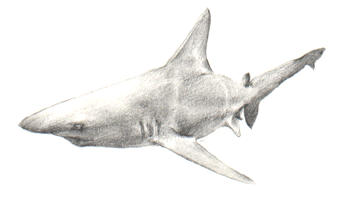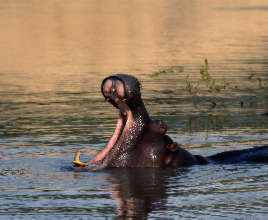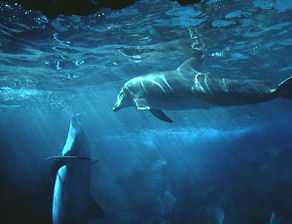Communicating Using Scent
Smell is probably the most common basic means of animal communication with even the most primitive animals reacting to odours given off by their own or other species.
Animals may use scents to proclaim their readiness to mate, to mark out territorial boundaries, to warn off intruders and predators or, in some cases, to attract prey. The most basic substance for these purposes is strong smelling urine, but there are other and more refined methods of producing lingering odours. These take the form of scent glands which may be situated in the hooves, on the face or close to the anus or scrotum.
Communication by scent can prove dangerous to certain animals such as the musk deer and certain civets. Their scent is so strong and persistent that their glands are highly prized by the makers of perfumes who use it as a stabiliser.
 Bees, wasps, ants, moths and other insects rely largely upon pheromones as a means of communication. Pheromones are chemical substances which may be secreted in urine, dung or produced by special glands. They are usually given off by the female of the species to attract males. For instance, the antennae of some male moths are so sensitive that they can detect the presence of a female at a distance of more than two miles!
Bees, wasps, ants, moths and other insects rely largely upon pheromones as a means of communication. Pheromones are chemical substances which may be secreted in urine, dung or produced by special glands. They are usually given off by the female of the species to attract males. For instance, the antennae of some male moths are so sensitive that they can detect the presence of a female at a distance of more than two miles!
Sharks have a particularly efficient sense of smell and some species can detect drops of blood in the ocean at a range of about one mile.
Snakes have the most unusual means of detecting scents. They use their tongue to pick up scent particles in the air. Having flicked out its tongue the snake then returns it to a special organ in the roof of the mouth which analyses the scents collected.
Dung is another readily available source of scent used by many animals to mark their territory, with some species accumulating and regularly adding to large heaps of droppings which act as territorial marker posts. The rabbit, vicuna, West African civet and hippopotamus are just four examples of these. Male hippos will mark their with their dung by using their tail as a kind of muck-spreader!
Communicating Using Sound
 If olfactory (scent) signs are the most common form of communication among animals, acoustic signals must surely be the next in line, as animals of all kinds rely to a great extent on their hearing ability in order to succeed and survive.
If olfactory (scent) signs are the most common form of communication among animals, acoustic signals must surely be the next in line, as animals of all kinds rely to a great extent on their hearing ability in order to succeed and survive.
Among mammals, generally speaking, small animals squeak and large ones rumble. The reason for this is that the smaller the animal's head, the higher the frequency of sound it can receive and transmit.
In order to determine which direction a sound is coming from, the brain must distinguish which ear it reaches first, and the time difference between them. The closer the animal's ears are together, the shorter the wavelength, and therefore the higher the frequency, will be necessary for good directional hearing.
However, just to show that nothing in nature can be taken for granted, some small-skulled species of birds can communicate with ultra-low sounds. In the case of mammals it must also be remembered that a large head and body allow space for bigger vocal equipment - so a roaring gerbil would seem quite out of place.
The acoustic communication signal most frequently heard by humans is, of course, bird song. On a still summer evening the territorial song of the male blackbird will carry a considerable distance, while the chiffchaff's distinctive call is something of a classic backing track to summers in the English countryside.
If we were to listen carefully we might also hear the chirping of crickets and grasshoppers together with the rather similar sounds made by shrews, but many of the acoustic signals transmitted by animals go unheard or unnoticed by humans.
 The largest of all animals, the whales, appear to be experts in the art of communication by sound, with each whale of the same species having its own repertoire of 'songs' which it repeats at intervals. Smaller whales such as the dolphins and porpoises also have a wide range of sounds, although these tend to be the clicking kind rather than 'songs'. These sounds alter quite noticeably when dolphins are hunting prey - being much more rapid and excited.
The largest of all animals, the whales, appear to be experts in the art of communication by sound, with each whale of the same species having its own repertoire of 'songs' which it repeats at intervals. Smaller whales such as the dolphins and porpoises also have a wide range of sounds, although these tend to be the clicking kind rather than 'songs'. These sounds alter quite noticeably when dolphins are hunting prey - being much more rapid and excited.
Very small creatures must also communicate with others of their kind and a good example of this is the acoustic signal of the death-watch beetle. These wood-eaters got their name because their taps and clicks on the rafters of houses were often heard by people sitting up all night to care for a dying relative.
Animals who live in a dense habitat such as wood transmit information by a form of Morse code achieved by banging their heads against the roof of their tunnel. This means of communication is clearly heard by humans.
Frogs too are frequently heard by humans, and frogs and toads have developed their vocal contact to a fine art by using bags of air as resonators. These may be situated in the mouth, throat or on the side of the head and they are acoustically most effective. A species of American tree frog provides an excellent example of the complex nature of communication among animals.
Although this frog gives a two-part call which humans hear in full the male frogs hear only the first part of the call which warns them of the presence of a male intruder, while the females hear only the second part which informs them of the presence of a potential mate!
Grasshoppers and crickets create sound by 'fiddling' - a process which consists of rubbing the hind legs over the ribs of the forewings. Male gorillas will beat their chest with cupped hands to produce a sound which carries some distance. This action is thought to be a form of communication although it could also be a means of releasing tension.
Elephants communicate by a series of rumbling noises made in their throats and trunks, although a cow elephant calling her calf will simply slap her ears against the side of her head. Trumpeting is restricted to moments of extreme excitement or danger.
 Kangaroos, hares and rabbits will thump their hind legs on the ground as a warning signal. The rattlesnake gives a distinctly audible and sinister sounding warning by vibrating its bell-shaped tail segments while other snakes, lizards and crocodilians will hiss loudly to warn off intruders.
Kangaroos, hares and rabbits will thump their hind legs on the ground as a warning signal. The rattlesnake gives a distinctly audible and sinister sounding warning by vibrating its bell-shaped tail segments while other snakes, lizards and crocodilians will hiss loudly to warn off intruders.
The study of acoustic communication among animals is producing new discoveries each year - leaving us to marvel at the complexity of nature and the way in which life on Earth has developed.
Communicating Using Visual Signals
Visual signals may take the form of gestures and display, facial grimaces, body posture or mimicry. The extravagant display of the peacock or lyre bird can make the strutting of a wood pigeon seem ineffective and yet each species has its own way of using visual communication to the best advantage.
The male rabbit will use the white underside of its tail to attract the attention of a female, while the female may use the white of her tail as a visual signal for her young to follow when she is leading them to the safety of the burrow.
Dogs and wolves make use of body language, as do cats, monkeys and many other animals. The attitude of the tail when two wolves meet will indicate which of the two is the superior. The tail held between the legs is a submissive gesture while the tail raised confidently aloft donates dominance. Horses will hold their ears or tail in certain positions to signal pleasure or alarm. Dogs wag their tails as a sign of pleasure while the waving tail of a cat signals irritation or anger. Raised hackles in the dog family help to make the individual appear bigger when facing a possible adversary.
Apes and monkeys make considerable use of facial grimaces in order to express their feelings. The frown of a rhesus monkey is a clear sign of unease, whereas the raised eyebrow and fluttering eyelid denotes friendship or pleasure.
At another level animals may communicate a simple message through the art of mimicry. The roundels on the wings of the peacock butterfly look like large and scary eyes to a potential predator. The harmless hoverfly resembles the wasp. Many caterpillars through their colouration take on the appearance of poisonous or evil-tasting creatures in order to deter their enemies.
With a little luck and a great deal of patience it is possible to observe and recognise visual communication among animals such as birds or insects in the garden. Observing the visual signals given by domestic animals like dogs or cats in the home will over time give you a good understanding of their feelings and mood.
Communicating Through Touch
 Although perhaps not as important or widespread as sound, scent or sight, a number of animals make use of touch in order to communicate their feelings to others of their kind.
Although perhaps not as important or widespread as sound, scent or sight, a number of animals make use of touch in order to communicate their feelings to others of their kind.
Humans may shake hands, kiss or hug when meeting as a sign of respect or affection.
Apes and monkeys will also hug and 'kiss' on meeting, although in certain species of monkey the visiting or newly arrived monkey will place its hand in the mouth of the monkey it is greeting. After a few moments the hand is withdrawn and the other monkey will place its hand in the mouth of the visitor. This appears to be a sign of trust and goodwill between monkeys.
Big cats tend to nuzzle each other, as do rhinos and many other animals. Elephants too use touch as a means of close communication - interlinking trunks.
There are of course huge numbers of other examples of how animals communicate with each other and we cannot cover them all. However, we hope that you may be inspired to find out even more, or perhaps to start observing your pets or even wild animals to see how they interact and communicate with one another. Who knows, maybe one day you will be an expert in the topic!
Credits
Image: Communication in Animals by Sarel Kromer
 Bees, wasps, ants, moths and other insects rely largely upon pheromones as a means of communication. Pheromones are chemical substances which may be secreted in urine, dung or produced by special glands. They are usually given off by the female of the species to attract males. For instance, the antennae of some male moths are so sensitive that they can detect the presence of a female at a distance of more than two miles!
Bees, wasps, ants, moths and other insects rely largely upon pheromones as a means of communication. Pheromones are chemical substances which may be secreted in urine, dung or produced by special glands. They are usually given off by the female of the species to attract males. For instance, the antennae of some male moths are so sensitive that they can detect the presence of a female at a distance of more than two miles!
 If olfactory (scent) signs are the most common form of communication among animals, acoustic signals must surely be the next in line, as animals of all kinds rely to a great extent on their hearing ability in order to succeed and survive.
If olfactory (scent) signs are the most common form of communication among animals, acoustic signals must surely be the next in line, as animals of all kinds rely to a great extent on their hearing ability in order to succeed and survive. The largest of all animals, the whales, appear to be experts in the art of communication by sound, with each whale of the same species having its own repertoire of 'songs' which it repeats at intervals. Smaller whales such as the dolphins and porpoises also have a wide range of sounds, although these tend to be the clicking kind rather than 'songs'. These sounds alter quite noticeably when dolphins are hunting prey - being much more rapid and excited.
The largest of all animals, the whales, appear to be experts in the art of communication by sound, with each whale of the same species having its own repertoire of 'songs' which it repeats at intervals. Smaller whales such as the dolphins and porpoises also have a wide range of sounds, although these tend to be the clicking kind rather than 'songs'. These sounds alter quite noticeably when dolphins are hunting prey - being much more rapid and excited. Kangaroos, hares and rabbits will thump their hind legs on the ground as a warning signal. The rattlesnake gives a distinctly audible and sinister sounding warning by vibrating its bell-shaped tail segments while other snakes, lizards and crocodilians will hiss loudly to warn off intruders.
Kangaroos, hares and rabbits will thump their hind legs on the ground as a warning signal. The rattlesnake gives a distinctly audible and sinister sounding warning by vibrating its bell-shaped tail segments while other snakes, lizards and crocodilians will hiss loudly to warn off intruders. Although perhaps not as important or widespread as sound, scent or sight, a number of animals make use of touch in order to communicate their feelings to others of their kind.
Although perhaps not as important or widespread as sound, scent or sight, a number of animals make use of touch in order to communicate their feelings to others of their kind. 